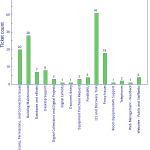Successful digitization results in a digital image that best depicts the physical item being digitized as accurately as possible. To ensure truthful color reproduction, color values must be matched to a known target. Library Technology and Digital Services recently acquired X-rite’s ColorChecker, color reference targets, and camera calibration software for use in the Digital Imaging Laboratory. A digital image of the ColorChecker’s reference target is captured by each digital camera in the laboratory. These images are uploaded in ColorChecker’s software to create a DNG file. The DNG file is used to create a color profile. The color profile is then…Read more What’s New in the Digital Imaging Laboratory
Category: News
LTDS August 12 – 19, 2018
The team continues to work on clean-up projects while balancing enhancements to Alma/Primo with other projects that were delayed due to implementation. Alma/Primo (Jamen, Nancy, Tao) Added users and refined roles Loaded orders Completed registration form and implemented Continued work on clean-up projects (removing duplicate barcodes) Discussed TOU changes Prepared for changes to the letters Working through migration issues Desktop/Application support (Judy, Matt) Replaced several smaller monitors Configured a new mac mini for Central reference Replaced and re-imaged several computers for staff Digital Collections (Nathan, Judy, Scott) Continued to add more items to Fedora Re-calibrated scanner Continued preparation for the…Read more LTDS August 12 – 19, 2018
LTDS Last week (July 23-28)
Alma, PrimoVE, and the web refresh went live Monday and Tuesday! Although these activities we the highlight of the week, the team also worked on several additional items including the issues below. Circulation transactions in Alma are duplicated Caused by some transactions not loading correctly during the final switch over. Ex Libris is working on the solution. We expect this to be resolved within a week Duplicate charges appearing in user accounts This is the same issue as #1 and should be resolved within a week Missing holding and item records Some of the items and data (<0.3%) did…Read more LTDS Last week (July 23-28)
Technical Freeze Starts This Weekend – So What Can I Do??
What is going to happen this weekend? What will I be able to do? What can be done during the Technical Services freeze? These are all valid and reasonable questions, which I will try to address in this post. No fear, though – you will still be able to work! Starting this weekend (June 22/23), as soon as Mary Ellen completes the fiscal year roll over (after which she will notify myself), I will launch several scripts on the Acorn server in order to do the full extract of our Symphony data. This is a server-load intensive process and requires…Read more Technical Freeze Starts This Weekend – So What Can I Do??
Zip File Importer for Islandora Now Available
Step by step instructions are now available for ingesting ZIP files into Vanderbilt’s Digital Collections, the central access point for the Vanderbilt Libraries’ digitized special collections. Instructions can be found here. https://ltds.library.vanderbilt.edu/library-staff-pages/islandora-ingest/ You must be logged in to access the link. Additional updates and changes are in store for Digital Collections in the coming weeks and months. Stay tuned!
Audio-Visual Resources in the Community Room
Video recording and streaming is now available in the Community Room for your meeting or event. The podium is height-adjustable with a lamp, microphone, computer with USB monitor, and HDMI and VGA video connections for use with laptops. Adapters are available for VGA to Mac video and HDMI to USB-C. A connection can also be made wirelessly using AirStream. Wireless laser pointers/clickers are available by request. Also on the podium is a touchscreen control for the projector, video camera, audio levels, light settings, and retractable video screen and window shades. A duplicate touchscreen control is located in the AV closet…Read more Audio-Visual Resources in the Community Room
Bring an Idea to Life with 3D Printing
Even though the Medical Library is closed for renovations, 3D printing is still available. Want to have something printed? Here is what you do: Email a link from a 3D printing file repository — Thingiverse, YouMagine, NIH 3D Print Exchange, etc. — or attach your file (.STL or .OBJ extensions only) to ebl3dprint@vanderbilt.edu. Want to try creating something yourself? Tinkercad, an easy-to-use online 3D CAD design tool, is a good place to start. We will take a look at the request and consult with you about printability, size, resolution, color, and timeframe. Then when it is ready to be picked up, we will…Read more Bring an Idea to Life with 3D Printing
Virtual Desktop Infrastructure (VDI) in the Libraries
Virtual Desktop Infrastructure (VDI) in the Libraries What is VDI? VDI utilizes a desktop computer to run software located on a remote server. This is the emerging campus standard, it is being implemented as the libraries move to VUIT desktop support for our public computers. Why is the University adopting VDIs? The goal of the VDI program is to reduce the overall costs of desktops across the University. As the Library has continued to increase support for digital initiatives, library staff available for desktop support has decreased. Utilizing the service offered by VUIT allows the public machines to be…Read more Virtual Desktop Infrastructure (VDI) in the Libraries
Lights, Camera, Action!
We now have the ability to stream and record video in the Community Room. We are still refining the recording and conversion process, but let us know if you would like video of your meeting or event.
Welcome to the LTDS website
Welcome to the LTDS website. LTDS has created this site to share additional information about LTDS team members and some of the current projects that Library Technology and Digital Services are involved . We will also post information about system issues and security warnings, technology tips, and other technology related items. A few of the featured pages are: System Status :This provides current uptime status for our public facing systems About : Lists some of the key services and responsibilities of LTDS About –> Team : Shows the organizational chart for LTDS and lists the team members Current Projects : …Read more Welcome to the LTDS website

